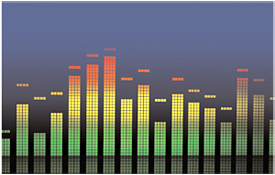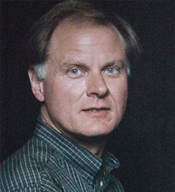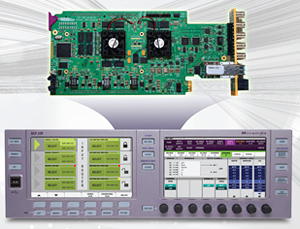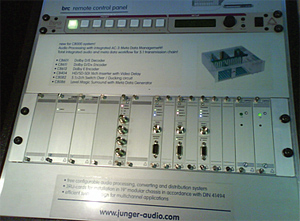ATSC Approves Loudness Practices
WASHINGTON

As the Commercial Advertisement Loudness Mitigation Act (CALM) makes its way through Congress after being passed the House Communications subcommittee last month, the Advanced Television Systems Committee (ATSC), which has promised to voluntarily introduce its own loudness standard, has sent a recommended practice (RP) document to its membership with the goal of publication in early November.
H.R. 1084 requires the FCC to adopt a broadcast loudness standard within a year of its enactment. It was introduced in February by Rep. Anna Eshoo (D-Calif.) after failing to get anywhere in 2008. The bill includes one-year hardship waivers for small TV stations and cable operators.
Meanwhile, broadcasters are hoping a voluntary “recommended practice” on audio loudness will help resolve some of the issues before the FCC has to get involved. “Techniques for Establishing and Maintaining Audio Loudness for Digital Television” was completed by the ATSC in late August and was balloted and approved by the Technology and Standards Group within the organization in September, according to Jim Starzynski, principal engineer and audio architect, NBC Universal, Advanced Engineering.

Jim Starzynski ”Leadership in the ATSC formed S6-3 in 2007 when they realized that more consistent audio practices could improve consumers’ listening experience in digital television,” Starzynski elaborated. Starzynski is leader of the ATSC’s Audio Loudness Group (S6-3) within the Specialist Group on Video and Audio Coding (TSG/S6), and a presenter at the 2009 ATSC Seminar on Audio Loudness, Nov. 4 in Washington, D.C.
“Program to interstitial content transitions were one issue, but channel changing was another. The formation of S6-3 created an opportunity for experts from the major networks, cable, manufacturing, content creation and more to surface the problems and document the solutions.”
He continued, “The recommended practice offers guidance on how to create and distribute content. If all contributors throughout the production and distribution chain follow the RP, the viewer experience will reflect the content provider’s intent offering excellent dynamic range and consistent loudness from program to commercial and from channel to channel across the DTV ‘dial,’ reaching the full potential of the ATSC digital audio system.”
ITU ALGORITHM
In the United States, as in Europe and elsewhere, the broadcast industry has embraced the International Telecommunication Union’s recommendation for audio loudness, ITU-R BS.1770. The algorithm enables the measurement of subjective loudness and optimization of audio content through the application of metadata, in particular dialog normalization or dialnorm, in the Dolby AC-3 encoded bitstream.

Miranda Technologies new Automatic Loudness Control (ALC) incorporates Jünger Audio’s Level Magic technology. “It is because of the subjective quality of sound that S6-3 adopted ITU-R BS.1770 as the single recommended loudness measurement algorithm,” Starzynski said. “Extremely productive work out of the ITU and an independent ATSC study under the direction of Tomlinson Holman at the University of Southern California aided the group with its recommendation. ITU-R BS.1770 does an excellent job of modeling the hearing system; other metering practices do an excellent job of protecting the equipment. One of S6-3’s goals was to develop a measurement practice that works best with human loudness perception, and [it] chose ITU-R BS.1770.”
A variety of manufacturers have already incorporated ITU-R BS.1770 into their audio loudness metering, measurement and control products, and various groups worldwide, such as the Broadcast Committee of Advertising Practice (BCAP), part of Britain’s Advertising Standards Authority (ASA), have made it central to their recommended practices and regulations.
“S6-3’s membership was very aware of loudness management activity throughout the world,” said Starzynski. “In fact, a liaison between S6-3 and P/LOUD, the EBU group studying loudness, was formed early on. The ATSC recommended practice reflects the ITU-R BS.1770 measurement recommendation.”
MARKET SOLUTIONS
One of the first measurement products to market was the Dolby Labs LM100 Broadcast Loudness Meter, a natural adjunct to the company’s Dolby Digital (AC-3) products. The LM100, which utilizes ITU-R BS.1770/1 as its core measurement algorithm, also permits the selection of Leq(A) metering. The device employs proprietary Dialogue Intelligence technology to automatically analyze and measures the input signal only during the presence of dialog.

Linear Acoustic AERO.air Transmission Loudness Manager includes Dolby Pulse. Linear Acoustic recently introduced its CARBON Hybrid Metadata Loudness Controller at IBC 2009, along with one of the first implementations of Dolby Pulse, Dolby’s implementation of HE AAC, in its AERO.air Transmission Loudness Manager. The LAMBDA Professional Digital Audio and Metadata Monitor offers a comprehensive solution to loudness control, featuring metering plus numeric loudness and metadata displays together with an acoustically tuned speaker system.
“LAMBDA is the first audio monitor that can decode Dolby Digital (AC-3) directly from an applied DVB-ASI transport stream, analyze the results via ITU-R BS.1770 loudness measurement, and display critical metadata information helping broadcasters ensure an optimal audio experience for viewers as well as compliance with standards and regulations,” said Tim Carroll, founder and president of Linear Acoustic in Lancaster, Pa.

Junger Audio Level Magic DaySequerra, a developer of audio processing technology in West Berlin, N.J. has launched the iLM8 Intelligent Loudness Meter, which measures perceived loudness of eight channels of program audio using ITU-R BS.1770/1 and DTS Neural Loudness Measure (NLM) algorithms. According to partner DTS, the proprietary NLM algorithm was developed after extensive research into human hearing and perceived loudness.
In the U.K., facilities have been choosing DK-Technologies’ Loudness software to evaluate audio levels and comply with BCAP’s guidelines, which were published last year. Loud-ness software may be incorporated into DK’s flagship MSD600M ++ audio meter as well as into the new PT0760M waveform monitor and the standalone MSD100C Loudness meter.
Germany’s Jünger Audio recently teamed up with Harmonic to integrate its Level Magic automated audio level control technology into the Sunnyvale, California-based company’s video delivery solutions. Level Magic relies on a sophisticated adaptive level control algorithm and complies with ITU-R BS. 1770. Patrick Waddell, manager, Standards & Regulatory, at Harmonic heads up the ATSC’s TSG/S6 group.
Jünger’s Level Magic rack frame product can hold up to 16 cards, offering loudness control for 16 independent SDI video streams with up to eight audio channels each in just 3RU of space—a density unrivalled in the market, according to the company.
To help broadcasters eliminate loudness variation between program segments, Miranda Technologies in Montreal recently launched Automatic Loudness Control (ALC), which also incorporates Jünger Audio’s Level Magic technology. The Densité XVP family of 3Gbps/HD/SD signal processors is the first available with Automatic Loudness Control. ALC is available in two, six and eight-channel versions for 5.1, stereo and mono processing. Output loudness from modules equipped with ALC may be monitored according to ITU-R BS.1770.
Get the TV Tech Newsletter
The professional video industry's #1 source for news, trends and product and tech information. Sign up below.
